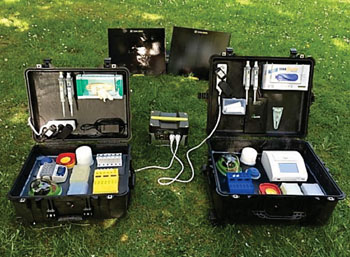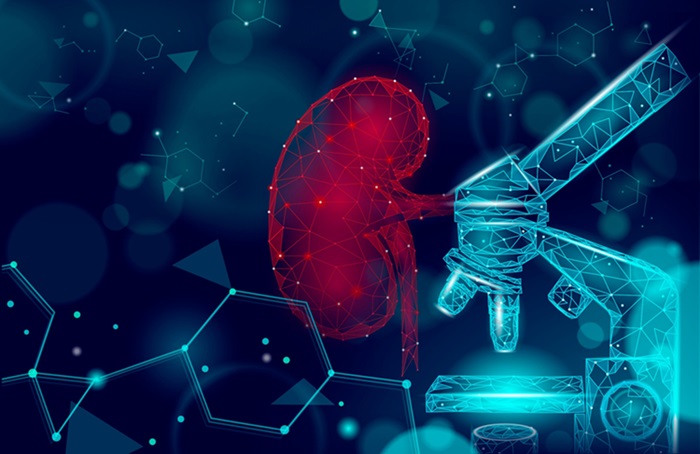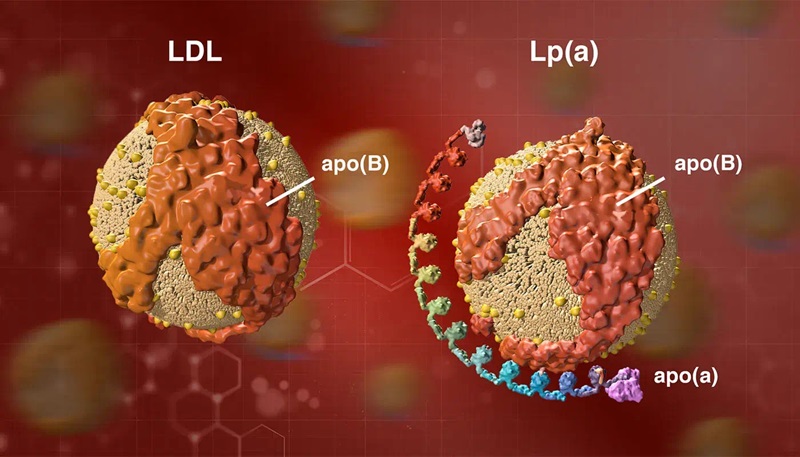Field Test Allows Rapid Diagnosis of Chikungunya Virus Infection
|
By LabMedica International staff writers Posted on 12 Oct 2016 |

Image: A suitcase laboratory used for Chikungunya virus (CHIKV) diagnosis in the field (Photo courtesy of Ahmed Abd El Wahed).
Chikungunya virus (CHIKV) infection causes symptoms that are similar to Dengue and Zika as well as other viral diseases, including influenza and accurate diagnosis of CHIKV is important for effective outbreak responses, including patient management and mosquito control.
A reverse transcriptase (RT) recombinase polymerase amplification (RPA) assay has been developed for rapid detection of CHIKV in clinical samples. RPA-based detection of small amounts of DNA is an alternative to polymerase chain reaction (PCR) and based on reactions that can run at constant temperatures.
An international team of scientists led by those at the Robert-Koch-Institute (Berlin, Germany) included in their study 78 patients with a history of sudden onset of fever, headache, fatigue, nausea, vomiting, rash, myalgia and severe and very painful polyarthralgia suggestive of CHIK infection. Fifty-eight plasma samples were provided by a group in Thailand and 20 CHIKV positive sera samples collected from patients suspected to be infected by CHIKV during routine medical examination, were provided by French scientists.
The team designed a set of CHIKV-specific reagents and showed that the assay was able to detect very small amounts of CHIKV ribonucleic acid (RNA). The RT-RPA assay was slightly less sensitive than RT-PCR, but both assays yielded identical results on clinical samples of 20 patients with known CHIKV infection and 58 samples from suspected cases.
Testing the RT-RPA assay on different CHIKV strains and a panel of related alpha - and arboviruses, the scientists found, that the assay reliably detected all 18 different CHIKV strains tested. In addition, there was no cross-reactivity of the assay with any of the other tested viruses except for the very closely related O'nyong'nyong virus (ONNV). Using a modified set of assay reagents, the scientists were able to eliminate the problem of false-positive results caused by ONNV. The diagnostic sensitivity and specificity of the CHIKV RT-RPA assay were determined at 100%.
The investigators highlighted that RPA reagents are stable at ambient temperature (25-38 °C), meaning they do not need to be refrigerated. The authors concluded that the CHIKV RPA assay is a promising tool for CHIKV diagnostics at the point of need. Integration into a multimer or multiplex assay for simultaneous and detection of CHIKV, Dengue virus and Zika virus as well as an internal control would improve outbreak investigations, since the three viruses induce same clinical picture upon infection and increasingly co-circulate in many parts of world. The study was published on September 29, 2016, in the journal Public Library of Science Neglected Tropical Diseases.
Related Links:
Robert-Koch-Institute
A reverse transcriptase (RT) recombinase polymerase amplification (RPA) assay has been developed for rapid detection of CHIKV in clinical samples. RPA-based detection of small amounts of DNA is an alternative to polymerase chain reaction (PCR) and based on reactions that can run at constant temperatures.
An international team of scientists led by those at the Robert-Koch-Institute (Berlin, Germany) included in their study 78 patients with a history of sudden onset of fever, headache, fatigue, nausea, vomiting, rash, myalgia and severe and very painful polyarthralgia suggestive of CHIK infection. Fifty-eight plasma samples were provided by a group in Thailand and 20 CHIKV positive sera samples collected from patients suspected to be infected by CHIKV during routine medical examination, were provided by French scientists.
The team designed a set of CHIKV-specific reagents and showed that the assay was able to detect very small amounts of CHIKV ribonucleic acid (RNA). The RT-RPA assay was slightly less sensitive than RT-PCR, but both assays yielded identical results on clinical samples of 20 patients with known CHIKV infection and 58 samples from suspected cases.
Testing the RT-RPA assay on different CHIKV strains and a panel of related alpha - and arboviruses, the scientists found, that the assay reliably detected all 18 different CHIKV strains tested. In addition, there was no cross-reactivity of the assay with any of the other tested viruses except for the very closely related O'nyong'nyong virus (ONNV). Using a modified set of assay reagents, the scientists were able to eliminate the problem of false-positive results caused by ONNV. The diagnostic sensitivity and specificity of the CHIKV RT-RPA assay were determined at 100%.
The investigators highlighted that RPA reagents are stable at ambient temperature (25-38 °C), meaning they do not need to be refrigerated. The authors concluded that the CHIKV RPA assay is a promising tool for CHIKV diagnostics at the point of need. Integration into a multimer or multiplex assay for simultaneous and detection of CHIKV, Dengue virus and Zika virus as well as an internal control would improve outbreak investigations, since the three viruses induce same clinical picture upon infection and increasingly co-circulate in many parts of world. The study was published on September 29, 2016, in the journal Public Library of Science Neglected Tropical Diseases.
Related Links:
Robert-Koch-Institute
Latest Molecular Diagnostics News
- Novel Technique Detects Novel Biomarkers for Kidney Diseases with Nephritic Syndrome
- Lipoprotein Blood Test Detects Hereditary Cardiovascular Risk
- Whole Genome Sequencing Detects Infection Transmission in NICU
- Novel Inexpensive, Shelf-Stable, Easy To Use Tests Bring Lab-Level Precision at POC
- World’s First One-Minute Hepatitis C Antibody Test Facilitates Quick Triage
- Game-Changing Blood Test for Stroke Detection Could Bring Life-Saving Care to Patients
- Blood Proteins Could Warn of Cancer Seven Years before Diagnosis
- New DNA Origami Technique to Advance Disease Diagnosis
- Ultrasound-Aided Blood Testing Detects Cancer Biomarkers from Cells
- New Respiratory Syndromic Testing Panel Provides Fast and Accurate Results
- New Synthetic Biomarker Technology Differentiates Between Prior Zika and Dengue Infections
- Novel Biomarkers to Improve Diagnosis of Renal Cell Carcinoma Subtypes
- RNA-Powered Molecular Test to Help Combat Early-Age Onset Colorectal Cancer
- Advanced Blood Test to Spot Alzheimer's Before Progression to Dementia
- Multi-Omic Noninvasive Urine-Based DNA Test to Improve Bladder Cancer Detection
- First of Its Kind NGS Assay for Precise Detection of BCR::ABL1 Fusion Gene to Enable Personalized Leukemia Treatment
Channels
Clinical Chemistry
view channel
New ADLM Guidance Provides Expert Recommendations on Clinical Testing For Respiratory Viral Infections
Respiratory tract infections, predominantly caused by viral pathogens, are a common reason for healthcare visits. Accurate and swift diagnosis of these infections is essential for optimal patient management.... Read more
3D Printed Point-Of-Care Mass Spectrometer Outperforms State-Of-The-Art Models
Mass spectrometry is a precise technique for identifying the chemical components of a sample and has significant potential for monitoring chronic illness health states, such as measuring hormone levels... Read more.jpg)
POC Biomedical Test Spins Water Droplet Using Sound Waves for Cancer Detection
Exosomes, tiny cellular bioparticles carrying a specific set of proteins, lipids, and genetic materials, play a crucial role in cell communication and hold promise for non-invasive diagnostics.... Read more
Highly Reliable Cell-Based Assay Enables Accurate Diagnosis of Endocrine Diseases
The conventional methods for measuring free cortisol, the body's stress hormone, from blood or saliva are quite demanding and require sample processing. The most common method, therefore, involves collecting... Read moreMolecular Diagnostics
view channel
Novel Technique Detects Novel Biomarkers for Kidney Diseases with Nephritic Syndrome
Nephrotic syndrome is associated with several kidney diseases such as minimal change disease (MCD), primary focal segmental glomerulosclerosis (FSGS), and membranous nephropathy (MN), and is characterized... Read more
Lipoprotein Blood Test Detects Hereditary Cardiovascular Risk
Lipoprotein (a), or Lp(a), is increasingly recognized as a critical but under-acknowledged potential risk factor for cardiovascular diseases, which are a significant public health concern.... Read more
Whole Genome Sequencing Detects Infection Transmission in NICU
A new study has shown that whole genome sequencing (WGS) of bacterial pathogens acquired from surveillance in a neonatal intensive care unit (NICU) can reveal significant infection transmission that goes... Read more
Novel Inexpensive, Shelf-Stable, Easy To Use Tests Bring Lab-Level Precision at POC
One of the most critical measurements in healthcare is the blood cell count, which can provide insights into a range of conditions from infections and autoimmune diseases to cancer. Traditionally, collecting... Read moreHematology
view channel
Next Generation Instrument Screens for Hemoglobin Disorders in Newborns
Hemoglobinopathies, the most widespread inherited conditions globally, affect about 7% of the population as carriers, with 2.7% of newborns being born with these conditions. The spectrum of clinical manifestations... Read more
First 4-in-1 Nucleic Acid Test for Arbovirus Screening to Reduce Risk of Transfusion-Transmitted Infections
Arboviruses represent an emerging global health threat, exacerbated by climate change and increased international travel that is facilitating their spread across new regions. Chikungunya, dengue, West... Read more
POC Finger-Prick Blood Test Determines Risk of Neutropenic Sepsis in Patients Undergoing Chemotherapy
Neutropenia, a decrease in neutrophils (a type of white blood cell crucial for fighting infections), is a frequent side effect of certain cancer treatments. This condition elevates the risk of infections,... Read more
First Affordable and Rapid Test for Beta Thalassemia Demonstrates 99% Diagnostic Accuracy
Hemoglobin disorders rank as some of the most prevalent monogenic diseases globally. Among various hemoglobin disorders, beta thalassemia, a hereditary blood disorder, affects about 1.5% of the world's... Read moreImmunology
view channel
Blood Test Measures Immune Response to Epstein-Barr Virus in MS Patients
Multiple sclerosis (MS) is a chronic neurological condition for which there is currently no cure. It affects around three million people globally and ranks as the second most common cause of disability... Read more.jpg)
AI Predicts Tumor-Killing Cells with High Accuracy
Cellular immunotherapy involves extracting immune cells from a patient's tumor, potentially enhancing their cancer-fighting capabilities through engineering, and then expanding and reintroducing them into the body.... Read more
Diagnostic Blood Test for Cellular Rejection after Organ Transplant Could Replace Surgical Biopsies
Transplanted organs constantly face the risk of being rejected by the recipient's immune system which differentiates self from non-self using T cells and B cells. T cells are commonly associated with acute... Read more
AI Tool Precisely Matches Cancer Drugs to Patients Using Information from Each Tumor Cell
Current strategies for matching cancer patients with specific treatments often depend on bulk sequencing of tumor DNA and RNA, which provides an average profile from all cells within a tumor sample.... Read morePathology
view channel
AI Tool Detects Tiny Protein Clumps in Microscopy Images in Real-Time
Over 55 million individuals worldwide suffer from dementia-related diseases like Alzheimer's and Parkinson's. These conditions are caused by the clumping together of the smallest building blocks in the... Read more
New Tool Enables Better Classification of Inherited Disease-Causing Variants
Whole genome and exome sequencing are increasingly available for clinical research, aiding in the detection of inherited genetic variants that may cause various diseases. The American College of Medical... Read more
Groundbreaking CRISPR Screen Technology Rapidly Determines Disease Mechanism from Tissues
Thanks to over a decade of advancements in human genetics, scientists have compiled extensive lists of genetic variations linked to a wide array of human diseases. However, understanding how a gene contributes... Read moreTechnology
view channel
New Diagnostic System Achieves PCR Testing Accuracy
While PCR tests are the gold standard of accuracy for virology testing, they come with limitations such as complexity, the need for skilled lab operators, and longer result times. They also require complex... Read more
DNA Biosensor Enables Early Diagnosis of Cervical Cancer
Molybdenum disulfide (MoS2), recognized for its potential to form two-dimensional nanosheets like graphene, is a material that's increasingly catching the eye of the scientific community.... Read more
Self-Heating Microfluidic Devices Can Detect Diseases in Tiny Blood or Fluid Samples
Microfluidics, which are miniature devices that control the flow of liquids and facilitate chemical reactions, play a key role in disease detection from small samples of blood or other fluids.... Read more
Breakthrough in Diagnostic Technology Could Make On-The-Spot Testing Widely Accessible
Home testing gained significant importance during the COVID-19 pandemic, yet the availability of rapid tests is limited, and most of them can only drive one liquid across the strip, leading to continued... Read moreIndustry
view channel
Roche and Hitachi High-Tech Extend 46-Year Partnership for Breakthroughs in Diagnostic Testing
Roche (Basel, Switzerland) and Hitachi High-Tech (Tokyo, Japan) have renewed their collaboration agreement, committing to a further 10 years of partnership. This extension brings together their long-standing... Read more
Danaher and Johns Hopkins University Collaborate to Improve Neurological Diagnosis
Unlike severe traumatic brain injury (TBI), mild TBI often does not show clear correlations with abnormalities detected through head computed tomography (CT) scans. Consequently, there is a pressing need... Read more
Beckman Coulter and MeMed Expand Host Immune Response Diagnostics Partnership
Beckman Coulter Diagnostics (Brea, CA, USA) and MeMed BV (Haifa, Israel) have expanded their host immune response diagnostics partnership. Beckman Coulter is now an authorized distributor of the MeMed... Read more_1.jpg)











